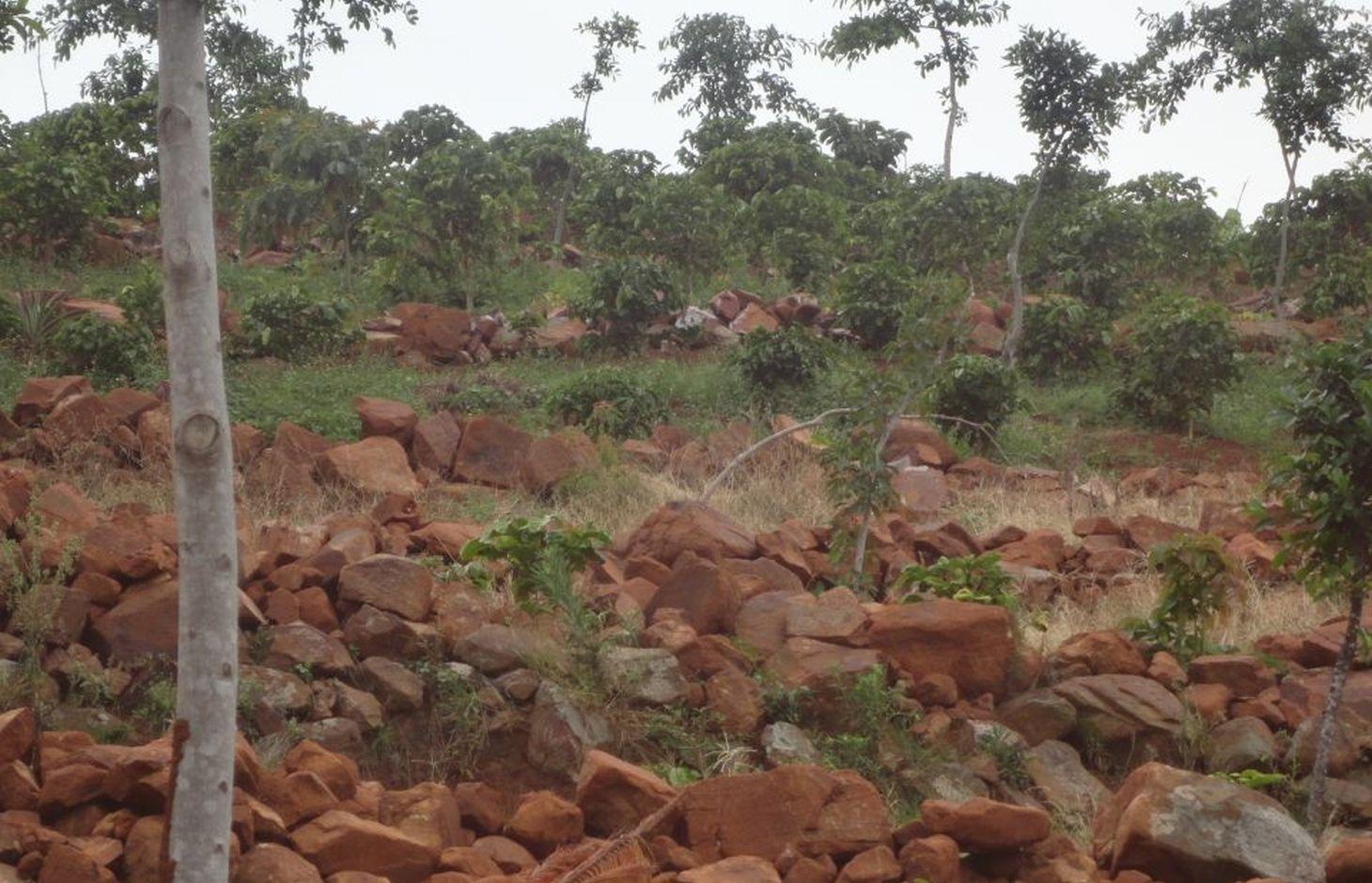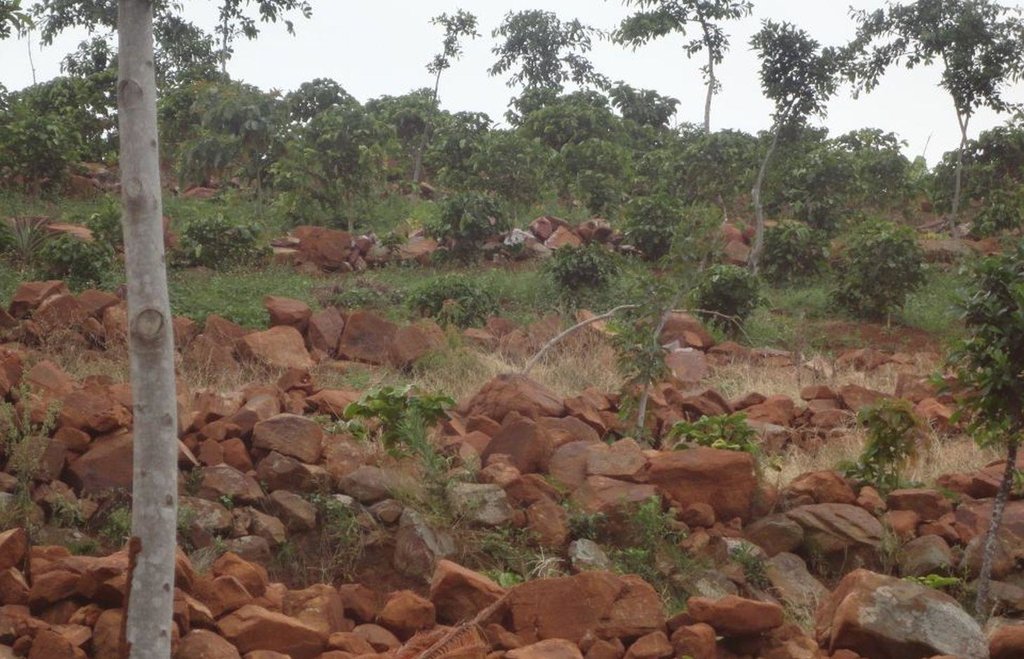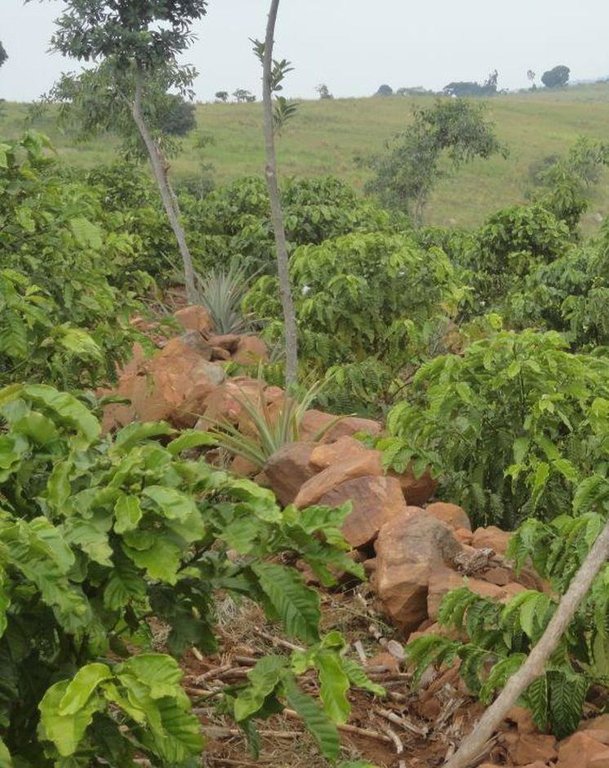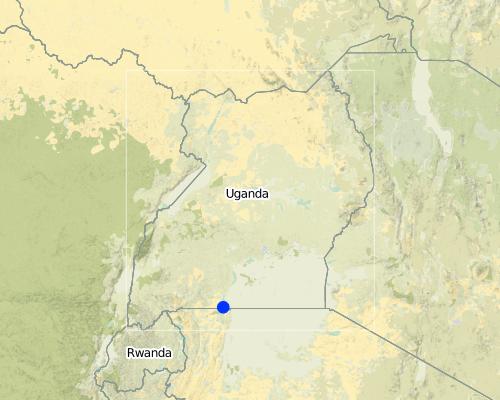Ficus Natalensis Agroforestry System [អ៊ូហ្គង់ដា]
- ការបង្កើត៖
- បច្ចុប្បន្នភាព
- អ្នកចងក្រង៖ Wilson Bamwerinde
- អ្នកកែសម្រួល៖ –
- អ្នកត្រួតពិនិត្យ Fabian Ottiger
Okusimba emituba n'ebimera
technologies_1153 - អ៊ូហ្គង់ដា
ពិនិត្យមើលគ្រប់ផ្នែក
ពង្រីកមើលទាំងអស់ បង្រួមទាំងអស់1. ព័ត៌មានទូទៅ
1.2 ព័ត៌មានលម្អិតពីបុគ្គលសំខាន់ៗ និងស្ថាប័នដែលចូលរួមក្នុងការវាយតម្លៃ និងចងក្រងឯកសារនៃបច្ចេកទេស
អ្នកជំនាញឯកទេស SLM:
អ្នកជំនាញឯកទេស SLM:
អ្នកជំនាញឯកទេស SLM:
Lubega Emmanuel
Rakai district
អ៊ូហ្គង់ដា
ឈ្មោះគម្រោងដែលបានចងក្រងឯកសារ/ វាយតម្លៃលើបច្ចេកទេស (បើទាក់ទង)
The Transboundary Agro-ecosystem Management Project for the Kagera River Basin (GEF-FAO / Kagera TAMP )ឈ្មោះអង្គភាពមួយ (ច្រើន) ដែលបានចងក្រងឯកសារ/ វាយតម្លៃបច្ចេកទេស (បើទាក់ទង)
Food and Agriculture Organization of the United Nations (FAO) - ប្រទេសអ៊ីតាលី1.3 លក្ខខណ្ឌទាក់ទងទៅនឹងការប្រើប្រាស់ទិន្នន័យដែលបានចងក្រងតាមរយៈ វ៉ូខេត
តើពេលណាដែលទិន្នន័យបានចងក្រង (នៅទីវាល)?
05/12/2013
អ្នកចងក្រង និង(បុគ្គលសំខាន់ៗ)យល់ព្រមទទួលយកនូវលក្ខខណ្ឌនានាទាក់ទងទៅនឹងការប្រើប្រាស់ទិន្នន័យដែលបានចងក្រងតាមរយៈវ៉ូខេត:
បាទ/ចា៎
1.5 ការយោងទៅលើកម្រងបញ្ជីសំណួរនៃវិធីសាស្ត្រផ្សព្វផ្សាយ SLM

Community development appraoch [អ៊ូហ្គង់ដា]
The approach involves the community and other development partners identifying opportunities, challenges and appropriate solutions through collective action.
- អ្នកចងក្រង៖ Wilson Bamwerinde
2. ការពណ៌នាពីបច្ចេកទេស SLM
2.1 ការពណ៌នាដោយសង្ខេបពីបច្ចេកទេស
និយមន័យបច្ចេកទេស:
Ficus natalensis based agroforestry system protects crops on windy hill slopes facing Lake Victoria and reduce runoff towards the meandering Kagera River Valley.
2.2 ការពណ៌នាលម្អិតពីបច្ចេកទេស
ការពណ៌នា:
Ficus natalensis is traditionally scattered in crop fields as a land management practice in central and south-western Uganda. The improved technology designed through community participation involves planting lines of Ficus natalensis along the contour at an interval that enables the tree to provide shade to young crops without depriving them of sunshine. When planted together with coffee trees or in banana plantations, the tall Ficus tree forms the top storey that protects the crop from the hot sun.
Purpose of the Technology: The main purpose of Ficus based agroforestry is to protect the soil from erosion. Within 3 to 5 years the Ficus tree forms a deep root system that stabilizes the soil. In addition, it drops leaves which quickly decay to provide both soil cover and manure thereby increasing the fertility of the soil. The trees provide firewood, fodder for livestock and bark cloth which can be used domestically or sold to supplement household income. They also act as wind breaks.
Establishment / maintenance activities and inputs: Ficus Natalensis is propagated using cuttings from young branches which are planted vertically 6 m apart along a contour. Propagation material is readily available and cheap, making the technology inexpensive to establish. Any annual or perennial crop can be inter-cropped with Ficus spp. provided the tree canopy is managed well. The tree is quite robust and can attain heights of over 20m, with a very extensive canopy if left to grow. Pruning raises its canopy to the desired height above the ground. In its early stages, fencing is required to protect the tree from damage by livestock. Within 12 to 18 months, however, the tree is established enough to withstand browsing. Only simple tools like hoes and garden forks for digging holes/pits are essential for establishment of the technology. The implementation of the technology on steep slopes (> 50%) is not possible without other supportive SLM interventions, in Rakai these include construction of stone lines and mulch application.
Natural / human environment: The pruned branches of Ficus natalensis are used as fuel wood when dry. Therefore scarcity of fuel wood may lead to over-harvesting of branches and destroying the canopy. Nonetheless, the tree regenerates quickly with the coming of the rains. Ficus tree can live for a hundred years.
2.3 រូបភាពនៃបច្ចេកទេស
2.5 ប្រទេស/តំបន់/ទីតាំងកន្លែង ដែលបច្ចេកទេសត្រូវបានអនុវត្ត និងបានគ្រប់ដណ្តប់ដោយការវាយតម្លៃនេះ
ប្រទេស:
អ៊ូហ្គង់ដា
តំបន់/រដ្ឋ/ខេត្ត:
Uganda
បញ្ជាក់បន្ថែមពីលក្ខណៈនៃទីតាំង:
Rakai District (Kijonjo Parish)
មតិយោបល់:
Boundary points of the Technology area: -0.96681 31.69066; -0.96706 31.69111; -0.96717 31.69033; -0.96757 31.69038; -0.96774 31.69073
Map
×2.6 កាលបរិច្ឆេទនៃការអនុវត្ត
ប្រសិនបើមិនច្បាស់ឆ្នាំ សូមបញ្ជាក់កាលបរិច្ឆេទដែលប្រហាក់ប្រហែល:
- តិចជាង 10ឆ្នាំមុន (ថ្មី)
2.7 ការណែនាំពីបច្ចេកទេស
សូមបញ្ជាក់តើបច្ចេកទេសត្រូវបានណែនាំឱ្យអនុវត្តដោយរបៀបណា:
- តាមរយៈគម្រោង / អន្តរាគមន៍ពីខាងក្រៅ
មតិយោបល់ (ប្រភេទនៃគម្រោង ។ល។):
Agroforestry is a traditional practice but was reintroduced in a better structured, systematic form by organizations like VI-Agroforestry and Kagera TAMP.
3. ចំណាត់ថ្នាក់នៃបច្ចេកទេស SLM
3.1 គោលបំណងចម្បង (១ ឬច្រើន) នៃបច្ចេកទេសនេះ
- កាត់បន្ថយ, បង្ការ, ស្តារឡើងវិញនូវការធ្លាក់ចុះគុណភាពដី
- បង្កើតផលប្រយោជន៍សេដ្ឋកិច្ច
3.2 ប្រភេទដីប្រើប្រាស់មួយប្រភេទ (ច្រើនប្រភេទ) ដែលបានអនុវត្តបច្ចេកទេស

ដីដាំដំណាំ
- ដំណាំប្រចាំឆ្នាំ
- ដំណាំរយៈពេលវែង (មិនមែនឈើ)
- ប្រភេទដើមឈើធំៗ និងដើមឈើតូចៗ
ដំណាំចម្បង (ដំណាំកសិ-ឧស្សាហកម្ម និងដំណាំស្បៀង) :
Major cash crop tree and shrub cropping: Coffee
Major food crop perennial (non-woody) cropping: Banana
Major food crop annual cropping: Maize and beans

ចម្រុះ (ដំណាំ/ វាលស្មៅ/ ដើមឈើ)គិតទាំងកសិរុក្ខកម្ម
- កសិរុក្ខកម្ម
ផលិតផល/សេវាកម្មចម្បង:
Major cash crop: Coffee
Major food crop: Bananas
Major other crop: Ficus Spp.
មតិយោបល់:
Major land use problems (compiler’s opinion): Severe deforestation as trees were cut down for firewood, charcoal, timber and for agricultural use;
Overgrazing
Major land use problems (land users’ perception): Prolonged dry weather, destructive rainstorms and declining soil fertility
Type of cropping system and major crops comments: Agro-forestry is used in combination with banana and coffee growing.
3.3 ព័ត៌មានបន្ថែមអំពីអ្នកប្រើប្រាស់ដី
ការផ្គត់ផ្គង់ទឹកនៅកន្លែងអនុវត្តបច្ចេកទេស:
- ទឹកភ្លៀង
ចំនួនសារដែលដាំដំណាំក្នុងមួយឆ្នាំ:
- 2
សូមបញ្ជាក់:
Longest growing period in days: 120 Longest growing period from month to month: February to May Second longest growing period in days: 120 Second longest growing period from month to month: September to December
3.4 ក្រុម SLM ដែលបច្ចេកទេសស្ថិតនៅក្នុង
- កសិរុក្ខកម្ម
3.5 ការសាយភាយនៃបច្ចេកទេស
មតិយោបល់:
Total area covered by the SLM Technology is 0.06 m2.
The technology is becoming dominant in Kijonjo parish and other parts of Rakai district especially due to climatic changes that have led to shorter rainy seasons. However, farmers also recognize its potential for soil conservation.
3.6 វិធានការ SLM ដែលបញ្ចូលនូវបច្ចេកទេស

វិធានការក្សេត្រសាស្ត្រ
- A6៖ ផ្សេងៗ

វិធានការរុក្ខជាតិ
- V1: ឈើធំៗ និងដើមឈើតូចៗ

វិធានការរចនាស័ម្ពន្ធ
- S11: ផ្សេងៗ
មតិយោបល់:
Main measures: vegetative measures
Specification of other agronomic measures: mulching (supp.
Specification of other structural measures: stone lines (supp.
Type of vegetative measures: aligned: -contour
3.7 កំណត់ប្រភេទនៃការធ្លាក់ចុះគុណភាពដីសំខាន់ៗដែលបច្ចេកទេសនេះបានដោះស្រាយ

ការហូរច្រោះដីដោយសារទឹក
- Wt: ការបាត់ដីស្រទាប់លើដោយការហូរច្រោះ

ការធ្លាក់ចុះជីវសាស្ត្រនៃដី
- Bc: ការថយចុះនូវគម្របរុក្ខជាតិ
- Bq: ការថយចុះនូវជីវម៉ាស/ បរិមាណ
មតិយោបល់:
Main type of degradation addressed: Wt: loss of topsoil / surface erosion, Bc: reduction of vegetation cover, Bq: quantity / biomass decline
Main causes of degradation: soil management (Lack of conservation measures), crop management (annual, perennial, tree/shrub) (Over cultivation), deforestation / removal of natural vegetation (incl. forest fires) (Cutting trees for timber and opening up more agricultural land), over-exploitation of vegetation for domestic use (Cutting trees for fuel wood and charcoal), poverty / wealth, education, access to knowledge and support services
Secondary causes of degradation: other natural causes (avalanches, volcanic eruptions, mud flows, highly susceptible natural resources, extreme topography, etc.) specify (Steep and very steep slopes)
3.8 ការពារ កាត់បន្ថយ ឬស្តារឡើងវិញនៃការធ្លាក់ចុះគុណភាពដី
បញ្ជាក់ពីគោលដៅរបស់បច្ចេកទេស ដែលផ្តោតទៅការធ្លាក់ចុះគុណភាពដី:
- ការកាត់បន្ថយការធ្លាក់ចុះគុណភាពដី
4. បច្ចេកទេសជាក់លាក់ សកម្មភាពអនុវត្ត ធាតុចូល និងថ្លៃដើម
4.1 គំនូសបច្ចេកទេសនៃបច្ចេកទេសនេះ
4.2 លក្ខណៈពិសេសនៃបច្ចេកទេស/ ពណ៌នាពីគំនូរបច្ចេកទេស
A diagram showing Ficus spp. trees planted to provide shade to coffee trees.
Location: Kijonjo B. village. Rakai
Date: 2013-12-05
Technical knowledge required for field staff / advisors: moderate (Knowledge of which trees will do well with the crops to be cultivated)
Technical knowledge required for land users: low (Land user dedication and a little guidance is enough for the implementation of the technology.)
Main technical functions: control of raindrop splash, control of dispersed runoff: impede / retard, improvement of ground cover, stabilisation of soil (eg by tree roots against land slides), reduction in wind speed, spatial arrangement and diversification of land use
Secondary technical functions: increase in organic matter, increase in nutrient availability (supply, recycling,…), increase of infiltration, increase / maintain water stored in soil, sediment retention / trapping, sediment harvesting, increase of biomass (quantity)
Aligned: -contour
Vegetative material: T : trees / shrubs
Number of plants per (ha): 250
Vertical interval between rows / strips / blocks (m): 20m
Spacing between rows / strips / blocks (m): 2m
Vertical interval within rows / strips / blocks (m): 2m
Width within rows / strips / blocks (m): 20m
Trees/ shrubs species: Ficus natalensis (also serves as perennial fodder), planted in the field using stem cuttings
Perennial crops species: Robusta coffee planted using seedlings bought from specialized nurseries
Slope (which determines the spacing indicated above): 35%
4.3 ព័ត៌មានទូទៅដែលពាក់ព័ន្ធនឹងការគណនាធាតុចូល និងថ្លៃដើម
ផ្សេងៗ/ រូបិយប័ណ្ណជាតិ (បញ្ជាក់):
Ushs
កំណត់អត្រាប្តូរប្រាក់ពីដុល្លាទៅរូបិយប័ណ្ណតំបន់ (បើទាក់ទង)៖ 1 ដុល្លារ =:
2500,0
កំណត់ថ្លៃឈ្នួលជាមធ្យមនៃការជួលកម្លាំងពលកម្មក្នុងមួយថ្ងៃ:
2.00
4.4 សកម្មភាពបង្កើត
| សកម្មភាព | ប្រភេទវិធានការ | ពេលវេលា | |
|---|---|---|---|
| 1. | Sourcing planting materials | សារពើរុក្ខជាតិ | Beginning of rains |
| 2. | Making pits | សារពើរុក្ខជាតិ | Beginning of rains |
| 3. | Planting cuttings | សារពើរុក្ខជាតិ | Wet season |
| 4. | Spot weeding | សារពើរុក្ខជាតិ | Wet season |
4.5 ថ្លៃដើម និងធាតុចូលដែលត្រូវការសម្រាប់ការបង្កើតបច្ចេកទេស
| បញ្ជាក់ពីធាតុចូល | ឯកតា | បរិមាណ | ថ្លៃដើមក្នុងមួយឯកតា | ថ្លៃធាតុចូលសរុប | % នៃថ្លៃដើមដែលចំណាយដោយអ្នកប្រើប្រាស់ដី | |
|---|---|---|---|---|---|---|
| កម្លាំងពលកម្ម | Sourcing planting materials | ha | 1,0 | 30,0 | 30,0 | 100,0 |
| កម្លាំងពលកម្ម | Making pits | ha | 1,0 | 30,0 | 30,0 | 100,0 |
| កម្លាំងពលកម្ម | Planting cuttings | ha | 1,0 | 8,0 | 8,0 | |
| កម្លាំងពលកម្ម | Spot weeding | ha | 1,0 | 8,0 | 8,0 | |
| សម្ភារៈ | 2 panga | ha | 1,0 | 8,0 | 8,0 | 100,0 |
| សម្ភារៈ | 2 hoes | ha | 1,0 | 8,0 | 8,0 | 100,0 |
| សម្ភារៈដាំដុះ | Cuttings (500 stern cuttings) | ha | 1,0 | 30,0 | 30,0 | |
| ថ្លៃដើមសរុបក្នុងការបង្កើតបច្ចេកទេស | 122,0 | |||||
មតិយោបល់:
Duration of establishment phase: 2 month(s)
4.6 សកម្មភាពថែទាំ
| សកម្មភាព | ប្រភេទវិធានការ | ពេលវេលា/ ភាពញឹកញាប់ | |
|---|---|---|---|
| 1. | Spot weeding | សារពើរុក្ខជាតិ | twice a year |
| 2. | Pruning | សារពើរុក្ខជាតិ | Wet season |
| 3. | Removing and processing the bark into bark cloth | សារពើរុក្ខជាតិ | Once in 2 years |
4.7 កំណត់ថ្លៃដើមសម្រាប់ការថែទាំ/ សកម្មភាពរបស់បច្ចេកទេស (ក្នុងរយៈពេលមួយឆ្នាំ)
| បញ្ជាក់ពីធាតុចូល | ឯកតា | បរិមាណ | ថ្លៃដើមក្នុងមួយឯកតា | ថ្លៃធាតុចូលសរុប | % នៃថ្លៃដើមដែលចំណាយដោយអ្នកប្រើប្រាស់ដី | |
|---|---|---|---|---|---|---|
| កម្លាំងពលកម្ម | Spot weeding | ha | 1,0 | 8,0 | 8,0 | 100,0 |
| កម្លាំងពលកម្ម | Pruning | ha | 1,0 | 8,0 | 8,0 | |
| កម្លាំងពលកម្ម | Removing and processing the bark into bark cloth | ha | 1,0 | 14,0 | 14,0 | |
| សម្ភារៈ | 1 panga | ha | 1,0 | 4,0 | 4,0 | 100,0 |
| សម្ភារៈ | 1 hoe | ha | 1,0 | 4,0 | 4,0 | |
| ថ្លៃដើមសរុបសម្រាប់ការថែទាំដំណាំតាមបច្ចេកទេស | 38,0 | |||||
មតិយោបល់:
Machinery/ tools: The technology only requires simple tools like hoes and pangas.
The costs were calculated for wind breaks and optimum canopy after establishment. Calculations were done in December 2013, considering activities of the previous (September-November) wet season.
4.8 កត្តាសំខាន់បំផុតដែលមានឥទ្ធិពលដល់ការចំណាយ
ពណ៌នាពីកត្តាប៉ះពាល់ចម្បងៗទៅលើថ្លៃដើម:
The most important factor affecting cost is labor to transport the bulky stem cuttings to the site. However, Ficus Natalensis is easy to establish and is durable (over 100 years) depending on management. It is extremely hardy and when it grows to 50cm to 100cm stem diameter it can be used for timber or to make dugout canoes. Establishment costs are easily recovered.
5. លក្ខណៈបរិស្ថានធម្មជាតិ និងមនុស្ស
5.1 អាកាសធាតុ
បរិមាណទឹកភ្លៀងប្រចាំឆ្នាំ
- < 250 មម
- 251-500 មម
- 501-750 មម
- 751-1,000 មម
- 1,001-1,500 មម
- 1,501-2,000 មម
- 2,001-3,000 មម
- 3,001-4,000 មម
- > 4,000 មម
លក្ខណៈពិសេស/ មតិយោបល់លើរដូវភ្លៀង:
The area receives two rainy seasons (March-May & September-December)
តំបន់កសិអាកាសធាតុ
- មានភ្លៀងមធ្យម
Thermal climate class: tropics. The area lies at the equator.
The area has a dry and a wet season, but other factors influencing its weather include proximity to Lake Victoria and the Kagera River.
5.2 សណ្ឋានដី
ជម្រាលជាមធ្យម:
- រាបស្មើ (0-2%)
- ជម្រាលតិចតួច (3-5%)
- មធ្យម (6-10%)
- ជម្រាលខ្ពស់បន្តិច (11-15%)
- ទីទួល (16-30%)
- ទីទួលចោត (31-60%)
- ទីទួលចោតខ្លាំង (>60%)
ទម្រង់ដី:
- ខ្ពង់រាប
- កំពូលភ្នំ
- ជម្រាលភ្នំ
- ជម្រាលទួល
- ជម្រាលជើងភ្នំ
- បាតជ្រលងភ្នំ
តំបន់តាមរយៈកម្ពស់ :
- 0-100 ម
- 101-500 ម
- 501-1,000 ម
- 1,001-1,500 ម
- 1,501-2,000 ម
- 2,001-2,500 ម
- 2,501-3,000 ម
- 3,001-4,000 ម
- > 4,000 ម
បញ្ជាក់ថាតើបច្ចេកទេសនេះត្រូវបានអនុវត្តន៍នៅក្នុង:
- សណ្ឋានដីប៉ោង
មតិយោបល់ និងបញ្ចាក់បន្ថែមអំពីសណ្ឋានដី :
Altitudinal zone: 1001-1500 m a.s.l (1269-1310m a.s.l.)
Slopes on average: Steep (ranked 1, while technology is good for all kind of slope, the description given here is for a steep slope) and hilly (ranked 2)
5.3 ដី
ជម្រៅដីជាមធ្យម:
- រាក់ខ្លាំង (0-20 សម)
- រាក់ (21-50 សម)
- មធ្យម (51-80 សម)
- ជ្រៅ (81-120 សម)
- ជ្រៅខ្លាំង (> 120 សម)
វាយនភាពដី (ស្រទាប់លើ):
- គ្រើម/ មានពន្លឺ (ខ្សាច់)
- មធ្យម (ល្បាយ, ល្បាប់)
សារធាតុសរីរាង្គនៅស្រទាប់ដីខាងលើ:
- មធ្យម (1-3%)
បើអាចសូមភ្ជាប់ការពណ៌នាពីដីឱ្យបានច្បាស់ ឬព័ត៌មានដែលអាចទទួលបាន ឧ. ប្រភេទដី, pH ដី/ ជាតិអាស៊ីត, សមត្ថភាពផ្លាស់ប្តូរកាចុង, វត្តមាននីត្រូសែន, ភាពប្រៃ ។ល។:
Soil depth on average: Shallow (ranked 1) and very shallow (ranked 2). The technology has also adopted to moderate to deep soils to support root development of trees.
Soil texture: Coarse/light (ranked 1, 70% of the soil in the area is sandy) and medium (ranked 2, 20% of the soil is loamy)
Soil fertility: Medium
Topsoil organic matter: Medium (the organic matter is medium but has improved with agroforestry)
Soil drainage/infiltration: Good (soils are manly sandy)
Soil water storage capacity: Low (soils are predominantly sandy)
5.4 ទឹកដែលអាចទាញមកប្រើប្រាស់បាន និងគុណភាពទឹក
នីវ៉ូទឹកក្រោមដី:
5-50 ម
ទឹកលើដីដែលអាចទាញយកប្រើប្រាស់បាន:
មិនមាន/ គ្មាន
គុណភាពទឹក (មិនបានធ្វើប្រត្តិកម្ម):
ទឹកពិសារដែលគ្មានគុណភាព (តម្រូវឱ្យមានការសំអាត)
មតិយោបល់ និងលក្ខណៈពិសេសផ្សេងៗទៀតលើគុណភាព និងបរិមាណទឹក :
Ground water table: 5-50 m (The technology does best in soils with ground table of 5-50m to enable root developement)
Availability of surface water: Poor/none (ranked 1, there is no surface water in dry season) and medium (ranked 2, some, in the wet season)
Water quality (untreated): Poor drinking water (treatement required, from unprotected source in swamps)
5.5 ជីវៈចម្រុះ
ភាពសម្បូរបែបនៃប្រភេទ:
- កម្រិតមធ្យម
មតិយោបល់ និងលក្ខណៈពិសេសផ្សេងទៀតលើជីវចម្រុះ:
While the surrounding valleys below are swampy and very rich in biodiversity, only a fraction remains at the slopes due to destruction of habitats.
5.6 លក្ខណៈនៃអ្នកប្រើប្រាស់ដីដែលអនុវត្តបច្ចេកទេស
ទីផ្សារនៃប្រព័ន្ធផលិតកម្ម:
- សម្រាប់ហូបក្នុងគ្រួសារ (ផ្គត់ផ្គង់ខ្លួនឯង)
- ពាក់កណ្តាលពាណិជ្ជកម្ម (ផ្គត់ផ្គង់ខ្លួនឯង/ ពាណិជ្ជកម្ម
ចំណូលក្រៅកសិកម្ម:
- តិចជាង 10% នៃចំណូល
កម្រិតជីវភាព:
- មធ្យម
- មាន
ឯកជន ឬក្រុម:
- ធ្វើខ្លួនឯង/ គ្រួសារ
កម្រិតប្រើប្រាស់គ្រឿងយន្ត:
- ប្រើកម្លាំងពលកម្ម
យេនឌ័រ:
- ស្ត្រី
- បុរស
សូមបញ្ជាក់ពីលក្ខណៈពាក់ព័ន្ធផ្សេងទៀតអំពីអ្នកប្រើប្រាស់ដី:
Land users applying the Technology are mainly common / average land users
Difference in the involvement of women and men: n/a
Population density: 100-200 persons/km2
Annual population growth: 1% - 2%
21% of the land users are rich and own 57% of the land (Business men.).
63% of the land users are average wealthy and own 34% of the land (Teachers).
16% of the land users are poor and own 9% of the land (orphans and widows.).
Off-farm income specification: There is a difference in income levels between those who have implemented the technology and those who have not.
Level of mechanization: Manual work (only manual labour is used-casual labourers)
Market orientation: Subsistence (ranked 1, most produce is for home consumption only surplus is sold) and mixed (ranked 2)
5.7 ទំហំផ្ទៃដីជាមធ្យមនៃដីផ្ទាល់ខ្លួន ឬជួលគេដែលបានអនុវត្តបច្ចេកទេស
- < 0.5 ហិកតា
- 0.5-1 ហិកតា
- 1-2 ហិកតា
- 2-5 ហិកតា
- 5-15 ហិកតា
- 15-50 ហិកតា
- 50-100 ហិកតា
- 100-500 ហិកតា
- 500-1,000 ហិកតា
- 1,000-10,000 ហិកតា
- > 10,000 ហិកតា
តើផ្ទៃដីនេះចាត់ទុកជាទំហំកម្រិតណាដែរ ខ្នាតតូច មធ្យម ឬខ្នាតធំ (ធៀបនឹងបរិបទតំបន់)?
- ខ្នាតតូច
មតិយោបល់:
Average area of land owned or leased by land users applying the Technology:
Ranked 1: 0.5-1 ha. For most average income families.
Ranked 2: <0.5-1ha. For the poor.
Ranekd 3: 1-2 ha. For the rich households.
5.8 ភាពជាម្ចាស់ដី កម្មសិទ្ធប្រើប្រាស់ដី និងកម្មសិទ្ធប្រើប្រាស់ទឹក
ភាពជាម្ចាស់ដី:
- ឯកជន មិនមានកម្មសិទ្ធ
- ឯកជន មានកម្មសិទ្ធ
កម្មសិទ្ធិប្រើប្រាស់ដី:
- ឯកជន
កម្មសិទ្ធប្រើប្រាស់ទឹក:
- អាស្រ័យផលសេរី (មិនមានការកំណត់)
មតិយោបល់:
Most land users have access to untittled land and have open access to water.
5.9 ការប្រើប្រាស់សេវាកម្ម និងហេដ្ឋារចនាសម្ព័ន្ធ
សុខភាព:
- មិនល្អ
- មធ្យម
- ល្អ
ការអប់រំ:
- មិនល្អ
- មធ្យម
- ល្អ
ជំនួយបច្ចេកទេស:
- មិនល្អ
- មធ្យម
- ល្អ
ការងារ (ឧ. ការងារក្រៅកសិដ្ឋាន):
- មិនល្អ
- មធ្យម
- ល្អ
ទីផ្សារ:
- មិនល្អ
- មធ្យម
- ល្អ
ថាមពល:
- មិនល្អ
- មធ្យម
- ល្អ
ផ្លូវ និងការដឹកជញ្ជូន:
- មិនល្អ
- មធ្យម
- ល្អ
ទឹកផឹក និងអនាម័យ:
- មិនល្អ
- មធ្យម
- ល្អ
សេវាកម្មហិរញ្ញវត្ថុ:
- មិនល្អ
- មធ្យម
- ល្អ
6. ផលប៉ះពាល់ និងការសន្និដ្ឋាន
6.1 ផលប៉ះពាល់ក្នុងបរិវេណអនុវត្តបច្ចេកទេសដែលកើតមាន
ផលប៉ះពាល់លើសេដ្ឋកិច្ចសង្គម
ផលិតផល
ផលិតកម្មដំណាំ
គុណភាពមុន SLM:
100
គុណភាពក្រោយ SLM:
400
មតិយោបល់/ ការបញ្ជាក់:
coffee and bananas
ផលិតកម្មឈើ
មតិយោបល់/ ការបញ្ជាក់:
For wood fuel (firewood & charcoal). there was almost nothing before.
ហានិភ័យនៃភាពបរាជ័យរបស់ផលិតកម្ម
មតិយោបល់/ ការបញ្ជាក់:
conservation of moisture, improved soil fertility
ភាពសម្បូរបែបនៃផលិតផល
ផ្ទៃដីផលិតកម្ម
មតិយោបល់/ ការបញ្ជាក់:
Agricultural land on which Ficus is planted
ចំណូល និងថ្លៃដើម
ចំណូលក្នុងកសិដ្ឋាន
មតិយោបល់/ ការបញ្ជាក់:
respondents reported increses in income but not documented.
ភាពសម្បូរបែបប្រភពប្រាក់ចំណូល
បន្ទុកការងារ
មតិយោបល់/ ការបញ្ជាក់:
Realization of the benefits has led many farmers to need more help therefore raising the cost of labour
ផលប៉ះពាល់ទៅលើវប្បធម៌សង្គម
សន្តិសុខស្បៀង/ ភាពគ្រប់គ្រាន់ខ្លួនឯង
មតិយោបល់/ ការបញ្ជាក់:
incresed agricultural produce.
ឱកាសវប្បធម៍
មតិយោបល់/ ការបញ្ជាក់:
backcloth is used for cultural functions .eg. burying the dead.
ការកាត់បន្ថយជម្លោះ
Improved livelihoods and human well-being
មតិយោបល់/ ការបញ្ជាក់:
The technology has improved availability of both food and fuel wood. Some products from trees used in agroforestry such as backcloth (Embugo - Luganda) are sold, diversifying household income.
ផលប៉ះពាល់ទៅលើអេកូឡូស៊ី
វដ្តទឹក/លំហូរ
លំហូរទឹកលើផ្ទៃដី
រំហួត
ដី
សំណើមដី
គម្របដី
ការបាត់បង់ដី
សារធាតុសរីរាង្គដី/ការបូនក្រោមដី
មតិយោបល់/ ការបញ្ជាក់:
dried tree leaves add humus and organic matter in the soil.
ជីវចម្រុះ៖ ដំណាំ, សត្វ
ជីវម៉ាស/ កាបូនលើដី
ភាពសម្បូរបែបនៃរុក្ខជាតិ
មតិយោបល់/ ការបញ្ជាក់:
various tree species are used for agroforestry.
ប្រភេទសត្វមានប្រយោជន៍
ភាពសម្បូរបែបនៃទីជំរក
ការគ្រប់គ្រងកត្តាចង្រៃ/ ជំងឺ
ការកាត់បន្ថយហានិភ័យនៃគ្រោះមហន្តរាយ និងគ្រោះអាកាសធាតុ
ដីបាក់/ លំហូរកំទិចកំទី
មតិយោបល់/ ការបញ្ជាក់:
Prevention of predisposition towards landslides
ល្បឿនខ្យល់
មតិយោបល់/ ការបញ្ជាក់:
windbreaks reduced wind velocity.
ផលប៉ះពាល់ទៅលើអេកូឡូស៊ីផ្សេងៗ
Risk of lightening strikes
6.2 ផលប៉ះពាល់ក្រៅបរិវេណអនុវត្តបច្ចេកទេសដែលកើតមាន
ទឹកជំនន់ខ្សែទឹកខាងក្រោម
កំណកល្បាប់ខ្សែទឹកខាងក្រោម
ទឹកក្រោមដី/ ការបំពុលទឹកទន្លេ
ខូចខាតដល់ស្រែអ្នកជិតខាង
6.3 ភាពប្រឈម និងភាពរួសនៃបច្ចេកទេសទៅនឹងការប្រែប្រួលអាកាសធាតុ និងគ្រោះអាកាសធាតុ/ គ្រោះមហន្តរាយ (ដែលដឹងដោយអ្នកប្រើប្រាស់ដី)
ការប្រែប្រួលអាកាសធាតុ
ការប្រែប្រួលអាកាសធាតុ
| រដូវកាល | ប្រភេទនៃការប្រែប្រួលអាកាសធាតុ/ព្រឹត្តិការណ៍ | លក្ខណៈឆ្លើយតបនៃបច្ចេកទេសទៅនឹងការប្រែប្រួលអាកាសធាតុ | |
|---|---|---|---|
| សីតុណ្ហភាពប្រចាំឆ្នាំ | កើនឡើង | ល្អ |
គ្រោះអាកាសធាតុ (មហន្តរាយ)
គ្រោះមហន្តរាយធម្មជាតិ
| លក្ខណៈឆ្លើយតបនៃបច្ចេកទេសទៅនឹងការប្រែប្រួលអាកាសធាតុ | |
|---|---|
| ព្យុះភ្លៀងតាមតំបន់ | មិនស្គាល់ |
| ព្យុះកំបុតត្បូងតាមតំបន់ | ល្អ |
គ្រោះមហន្តរាយអាកាសធាតុ
| លក្ខណៈឆ្លើយតបនៃបច្ចេកទេសទៅនឹងការប្រែប្រួលអាកាសធាតុ | |
|---|---|
| រាំងស្ងួត | ល្អ |
គ្រោះមហន្តរាយទឹក
| លក្ខណៈឆ្លើយតបនៃបច្ចេកទេសទៅនឹងការប្រែប្រួលអាកាសធាតុ | |
|---|---|
| ទឹកជំនន់ទូទៅ (ទន្លេ) | មិនស្គាល់ |
ផលវិបាកដែលទាក់ទងនឹងបរិយាកាសផ្សេងៗទៀត
ផលវិបាកដែលទាក់ទងនឹងបរិយាកាសផ្សេងៗទៀត
| លក្ខណៈឆ្លើយតបនៃបច្ចេកទេសទៅនឹងការប្រែប្រួលអាកាសធាតុ | |
|---|---|
| កាត់បន្ថយពេលដាំដុះ | ល្អ |
6.4 ការវិភាគថ្លៃដើម និងអត្ថប្រយោជន៍
តើផលចំណេញ និងថ្លៃដើមត្រូវបានប្រៀបធៀបគ្នាយ៉ាងដូចម្តេច (ទស្សនៈរបស់អ្នកប្រើប្រាស់ដី)?
រយៈពេលខ្លី:
វិជ្ជមាន
រយៈពេលវែង:
វិជ្ជមាន
តើផលចំណេញ និងការថែទាំ/ ជួសជុលត្រូវបានប្រៀបធៀបគ្នាយ៉ាងដូចម្តេច (ទស្សនៈរបស់អ្នកប្រើប្រាស់ដី)?
រយៈពេលខ្លី:
វិជ្ជមានខ្លាំង
រយៈពេលវែង:
វិជ្ជមានខ្លាំង
មតិយោបល់:
The costs for both establishment and maintenance are a small fraction of the benefits accruing from the technology.
6.5 ការទទួលយកបច្ចេកទេស
បើអាច សូមបញ្ជាក់ពីបរិមាណ (ចំនួនគ្រួសារ និង/ ឬតំបន់គ្របដណ្តប់):
8
ក្នុងចំណោមគ្រួសារទាំងអស់ដែលអនុវត្តបច្ចេកទេស តើមានប៉ុន្មានគ្រួសារដែលចង់ធ្វើដោយខ្លួនឯង ដោយមិនទទួលបានសម្ភារៈលើកទឹកចិត្ត/ប្រាក់ឧបត្ថម្ភ?:
- 90-100%
មតិយោបល់:
100% of land user families have adopted the Technology without any external material support
8 land user families have adopted the Technology without any external material support
Comments on spontaneous adoption: There is spontaneous adoption of the technology as it builds on traditional farming practices in the area.
There is a strong trend towards spontaneous adoption of the Technology
Comments on adoption trend: High demand for shade-grown coffee and bananas in addition to the highly valued bark cloth used in art and crafts has increased farmer appreciation.
6.7 ភាពខ្លាំង/ គុណសម្បត្តិ/ ឱកាសនៃបច្ចេកទេស
| ភាពខ្លាំង/ គុណសម្បត្តិ/ ឱកាសនៅកន្លែងរបស់អ្នកប្រើប្រាស់ដី |
|---|
|
Ficus is used to provide backcloth that is sold for the making of Art and crafts and for cultural functions. How can they be sustained / enhanced? Management to accelerate healing of the bark within a shorter period should be investigated |
|
Trees shield crops from dangerous storms /rains and intense sunshine. How can they be sustained / enhanced? Encourage the spread of the canopy |
|
Ficus is good and attractive to birds and insects How can they be sustained / enhanced? Provision of material support in form of seedlings, farm tools for accelerated multiplication |
|
Ficus natalensis leaves are cut and fed to livestock like goats. How can they be sustained / enhanced? Encourage indeginous trees and growing fodder crops such as calliandra and nappier grass |
| ភាពខ្លាំង/ គុណសម្បត្តិ/ ឱកាស ទស្សនៈរបស់បុគ្គលសំខាន់ៗ |
|---|
|
Demand for wood fuel is high How can they be sustained / enhanced? Local bye laws should be enacted to control deforestation and encourage tree growing |
|
It improves soil fertility-Ficus natalensis sheds leaves once every year, adding to soil humus. How can they be sustained / enhanced? More guidance should be given to the farmers for sustained spontaneous adoption of the technology |
|
It checks the speed of wind thereby protecting crops. How can they be sustained / enhanced? Other agricultural, ecological and social benefits could be explored in this scenic area facing the Kagera River where it enters Lake Victoria |
|
Stakes made from the Ficus branches can be used to grow climbing plants eg. passion fruits, yams as well as climbing beans How can they be sustained / enhanced? More tree planting should be encouraged |
|
Prevents soil erosion by checking raindrop splash, speed and amount of surface runoff and stabilizes the soil. How can they be sustained / enhanced? Because the ficus tree takes time to establish, other technologies such as trenches and grass strips could be used to reinforce it |
6.8 ភាពខ្សោយ/ គុណវិបត្តិ/ ហានិភ័យនៃបច្ចេកទេស និងវិធីសាស្ត្រដោះស្រាយ
| ភាពខ្សោយ/ គុណវិបត្តិ/ ហានិភ័យ ទស្សនៈរបស់អ្នកប្រើប្រាស់ដី | តើបច្ចេកទេសទាំងនោះបានដោះស្រាយបញ្ហាដូចម្តេច? |
|---|---|
| The trees can hinder crops from light if canopy is dense | Prune periodically to enable other crops access to light |
| Some trees can fall especially during heavy and stormy rains, damaging plants and animals. | cutting excessive branches to reduce the load borne by trees. |
| Trees can attract lightening ,which destroys plants and animals. | Avoid putting animals under tall trees. |
| ភាពខ្សោយ/ គុណវិបត្តិ/ ហានិភ័យ ទស្សនៈរបស់អ្នកចងក្រងឬបុគ្គលសំខាន់ៗ | តើបច្ចេកទេសទាំងនោះបានដោះស្រាយបញ្ហាដូចម្តេច? |
|---|---|
| Some tree species especially with short roots , compete with crops for nutrients. | Planting tree species with deep roots to avoid competition for nutrients. |
| It is a home for weaver birds and caterpillars. | Use scarecrows and biological control. |
7. ឯកសារយោង និងវេបសាយ
7.2 ឯកសារយោងដែលបានចេញផ្សាយ
ចំណងជើង អ្នកនិពន្ធ ឆ្នាំ ISBN:
Kagera TAMP project website
មានប្រភពមកពីណា? ថ្លៃដើមប៉ុន្មាន?
http://www.fao.org/nr/kagera/en/
ការតភ្ជាប់ និងម៉ូឌុល
ពង្រីកមើលទាំងអស់ បង្រួមទាំងអស់ការតភ្ជាប់

Community development appraoch [អ៊ូហ្គង់ដា]
The approach involves the community and other development partners identifying opportunities, challenges and appropriate solutions through collective action.
- អ្នកចងក្រង៖ Wilson Bamwerinde
ម៉ូឌុល
គ្មានម៉ូឌុល






